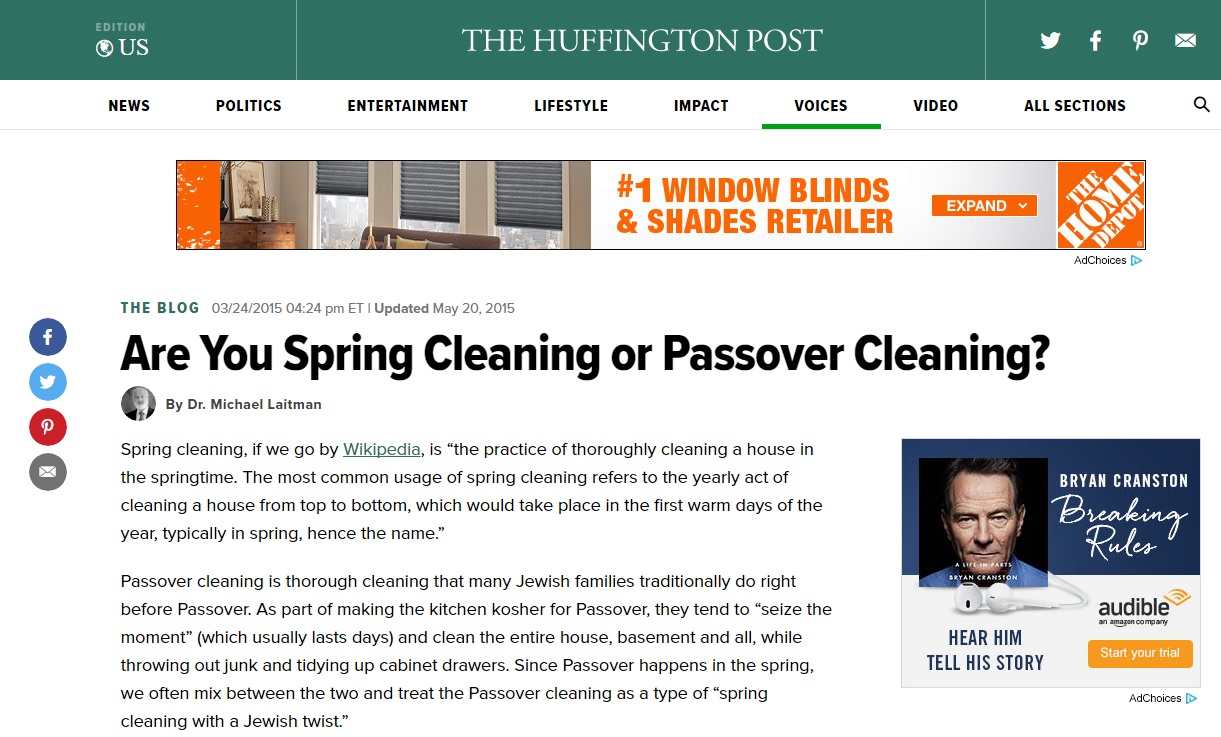
Spring cleaning, if we go by Wikipedia, is “the practice of thoroughly cleaning a house in the springtime. The most common usage of spring cleaning refers to the yearly act of cleaning a house from top to bottom, which would take place in the first warm days of the year, typically in spring, hence the name.”
Passover cleaning is thorough cleaning that many Jewish families traditionally do right before Passover. As part of making the kitchen kosher for Passover, they tend to “seize the moment” (which usually lasts days) and clean the entire house, basement and all, while throwing out junk and tidying up cabinet drawers. Since Passover happens in the spring, we often mix between the two and treat the Passover cleaning as a type of “spring cleaning with a Jewish twist.”
I’m all for cleanness and getting rid of junk, but the Passover cleaning actually has a far deeper meaning than mere dusting and tidying of basement closets. A person’s heart is considered one’s home. Cleaning one’s home means cleaning one’s heart from “junk,” namely from bad thoughts about others.
Passover marks the first time when we pass over from a self-centered mindset, otherwise known as “evil inclination,” and achieve the first degree of love of others—a ladder of brotherly love that we climb until we achieve a state known as “love your neighbor as yourself.” Before we come to that first step, we must scrutinize all our desires and thoughts, and avoid using all those that are self-inclined. This scrutiny is the Passover cleaning.
Incidentally, the typically extensive use of bleach during Passover cleaning fits right in with the internal meaning because cleaning one’s heart is also called “whitening” it. I doubt that this is what bleach manufacturers have in mind when they make it, but if the thought of this makes the vapor a bit more tolerable, it is at least a cold comfort.
On the night before Passover, after everything has been cleaned and bleached, there is a custom to spread ten pieces of hametz (leavened bread) around the house, and look for them by candlelight. As we find each of the pieces, we call out a name of one of the ten Sefirot—Keter, Hochma, Bina, Hesed, Gevura, Tifferet, Netzah, Hod, Yesod, Malchut. (Friendly tip: don’t hide the pieces where no one can find them if you want your house kosher for Passover.)
Here, too, the symbolism is that each Sefira (singular for Sefirot), whose related hametz we find, represents a correction of a certain type of desires and thoughts. The next morning, on Passover Eve, we burn the pieces of hametz we have collected, and declare that our home, meaning our heart, is free of any ill thoughts about others.
When that moment happens to us internally, we are ready to pass over from egoism to the first level of love of others, and our inner Passover begins.
The festival we celebrate happens each year on the 14th of Nisan. But internally, it can happen any time when we are ready to put our egos aside and connect to others with true brotherly love.
A short while after we pass over and cross the Red Sea, the Torah tells us, we receive the Torah at the foot of Mt. Sinai, the mountain of sinaa (hatred), hence the name Sinai. When we overcome the hatred and commit to be “as one man with one heart,” we become a nation, forged in unity and bonding.
But first, we have to pass over. So this Passover, whether we spring-clean or Passover-clean, let’s also clean our hearts a bit toward each other.
Happy Bleaching
Featured in Huffington Post